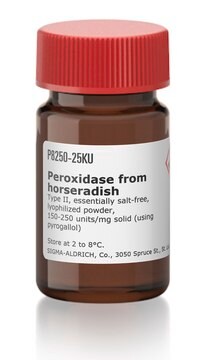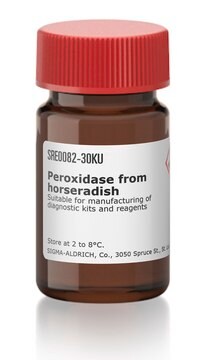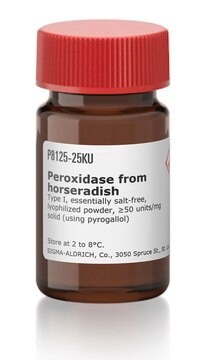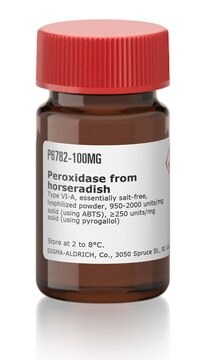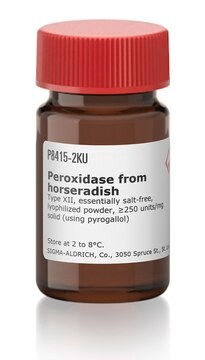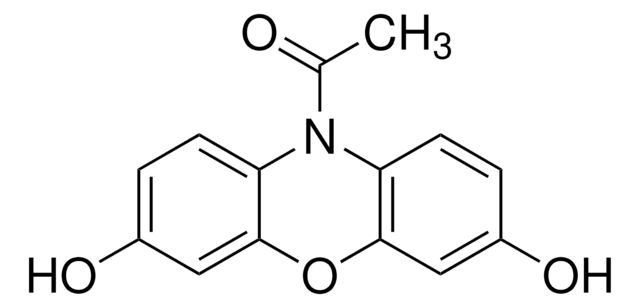10108090001
Roche
Peroxidase (POD)
grade I, from horseradish
Sinónimos:
POD, peroxidase
Iniciar sesiónpara Ver la Fijación de precios por contrato y de la organización
About This Item
Productos recomendados
origen biológico
horseradish
Nivel de calidad
Formulario
lyophilized (salt-free)
actividad específica
≥250 units/mg protein (At 25 °C with guaiacol and H2O2 as the substrates.)
250 U/mg
envase
pkg of 25,000 U
fabricante / nombre comercial
Roche
pH óptimo
6.0-6.5
Condiciones de envío
wet ice
temp. de almacenamiento
2-8°C
Descripción general
Donor:hydrogen-peroxide oxidoreductase
Peroxidase (POD) (E.C. 1.11.1.7) is extensively expressed in most fruits and vegetables.
Aplicación
Oxidation of electron donors (e.g., epoxidation of double bonds). Peroxidase can be coupled to other proteins via its amino groups, as well as its carbohydrate moiety. The reconstituted solution can be used directly for conjugation without prior dialysis.It has been used in ligand blotting.
Peroxidase (POD) has been used in AUR (Amplex UltraRed assay) to measure extracellular H2O2 produced from disaggregated slug cells.
Acciones bioquímicas o fisiológicas
Peroxidase (POD) is involved in the dehydrogenation of a large number of organic compounds including, phenols and aromatic amines, hydroquinones and hydroquinoid amines, mainly benzidine derivatives.
Calidad
Contaminants: <0.001% ATPase and acid phosphatase each, <0.7% catalase
Purity number: approximately 3.0 (A403/A275)
Purity number: approximately 3.0 (A403/A275)
Nota de preparación
Activator: Ammonia, pyridine, imidazole, all at pH >7; detergents.
Working solution: PBS (phosphate buffered saline) or water (starting concentration 20 mg/ml).
Working solution: PBS (phosphate buffered saline) or water (starting concentration 20 mg/ml).
Reconstitución
Solution (10 mg/ml in water): clear, red brown; pH-value: 6.0 to 7.0.
Otras notas
For life science research only. Not for use in diagnostic procedures.
Palabra de señalización
Danger
Frases de peligro
Consejos de prudencia
Clasificaciones de peligro
Resp. Sens. 1 - Skin Sens. 1
Código de clase de almacenamiento
11 - Combustible Solids
Clase de riesgo para el agua (WGK)
WGK 1
Punto de inflamabilidad (°F)
Not applicable
Punto de inflamabilidad (°C)
Not applicable
Elija entre una de las versiones más recientes:
¿Ya tiene este producto?
Encuentre la documentación para los productos que ha comprado recientemente en la Biblioteca de documentos.
Los clientes también vieron
Methods of Enzymatic Analysis (1974)
Social amoebae trap and kill bacteria by casting DNA nets
Zhang X, et al.
Nature Communications, 7, 10938-10938 (2016)
Inactivation and conformational change of horseradish peroxidase induced by pulsed electric field
Zhong K, et al.
Food Chemistry, 92(3), 473-479 (2005)
Mi Kyong Lee et al.
Applied and environmental microbiology, 69(8), 4648-4657 (2003-08-07)
The Vip3A protein, secreted by Bacillus spp. during the vegetative stage of growth, represents a new family of insecticidal proteins. In our investigation of the mode of action of Vip3A, the 88-kDa Vip3A full-length toxin (Vip3A-F) was proteolytically activated to
Xuezhi Zhang et al.
Nature communications, 7, 10938-10938 (2016-03-02)
Extracellular traps (ETs) from neutrophils are reticulated nets of DNA decorated with anti-microbial granules, and are capable of trapping and killing extracellular pathogens. Various phagocytes of mammals and invertebrates produce ETs, however, the evolutionary history of this DNA-based host defence
Nuestro equipo de científicos tiene experiencia en todas las áreas de investigación: Ciencias de la vida, Ciencia de los materiales, Síntesis química, Cromatografía, Analítica y muchas otras.
Póngase en contacto con el Servicio técnico
